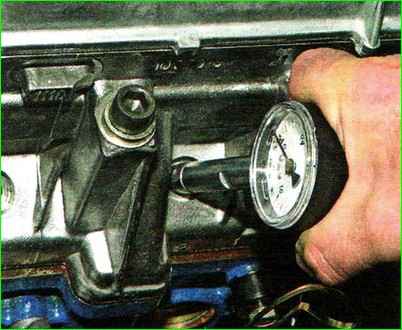We carry out a compression test for a general assessment of the technical condition of the parts of the cylinder-piston group and the engine valve mechanism
We carry out the check with an assistant on the engine, warmed up to operating temperature.
Relieve the pressure in the engine power supply system and do not replace the fuel pump fuse.
Unscrew the spark plugs from the holes in the cylinder head.
Disconnect the engine management system wiring harness block from the ignition coil.

Install the tip of the compression gauge into the spark plug hole of the cylinder head.
Crank the crankshaft with the starter while the gas pedal is fully pressed for 2-4 s (the pressure gauge readings should stop increasing).
Fix the pressure gauge reading and release the pressure in the compression gauge.
To correctly assess compression, the battery must be fully charged - the crankshaft revolutions during cranking must be at least 180 minutes -1.
We check the compression in other engine cylinders in the same way.
The compression of a working engine should be in the range of 11.0-13.0 bar, and the difference in readings between the cylinders should not exceed 1.0 bar.
To find out the reasons for low compression, pour 10-15 cm of 3 engine oil into the cylinder through the spark plug hole and repeat the measurement.
If, upon repeated measurement, the compression has increased by more than 2.0 bar, the most likely cause of the malfunction is severe wear, sticking or breakage of the piston rings.
If the compression remains the same, the valve plates may not fit tightly to the seats due to their damage (for example, burnout) or wear, as well as damage to the cylinder head gasket.
The cause of the malfunction can only be definitively determined after disassembling the engine.
You can try to eliminate valve obstruction with special preparations poured into the fuel tank or directly into the engine cylinders.
The tightness of the valves can be checked with compressed air under a pressure of 0.2-0.3 MPa (2-3 kgf/cm 3), supplied through the spark plug hole.
It is necessary to supply air when the camshaft is in a position when both valves of the cylinder being tested are closed.
If the exhaust valve is faulty, air will escape through the exhaust system, and if the intake valve is faulty, air will escape through the throttle assembly.
If the piston group is faulty, air will escape through the oil filler neck.
The release of air bubbles through the coolant in the expansion tank indicates a faulty cylinder head gasket.
You can roughly check whether there is compression in the cylinder without a compression gauge.
Insert a cork made from a piece of newspaper-type paper folded into the candle hole, approximately like a paper bottle cap.
You need to insert it tightly, and crank the engine; if the plug comes out, it means there is compression.
Thus, you can find the compression stroke in the cylinder, but you need to turn it not with the starter, but by lifting the front wheel and putting it in 4th or 5th gear and turning it by the wheel.
When the plug flies out, it means that at that moment the piston is in the compression stroke





